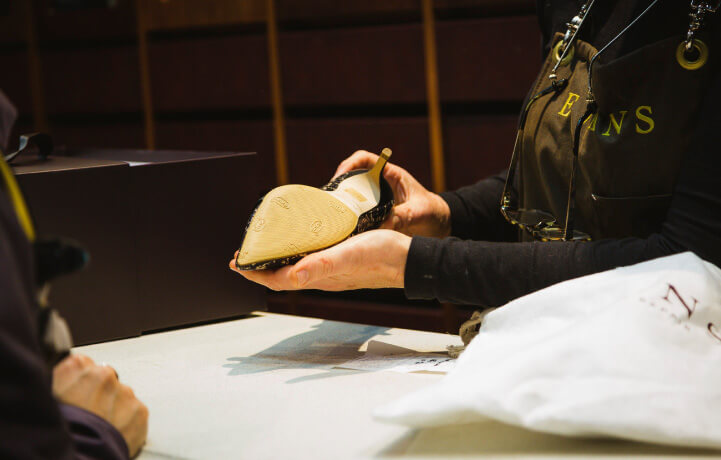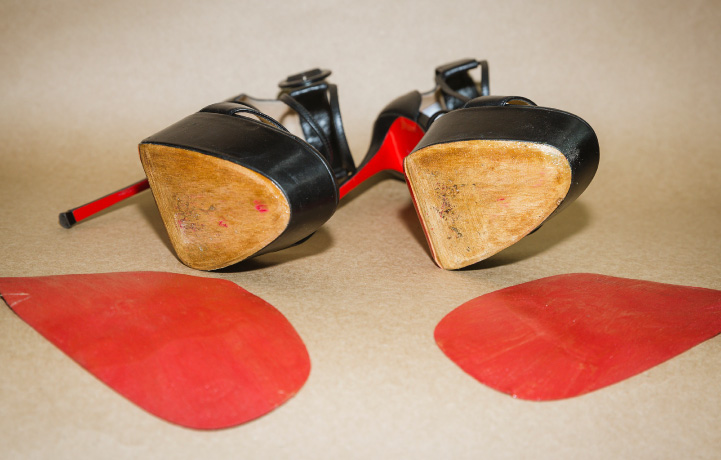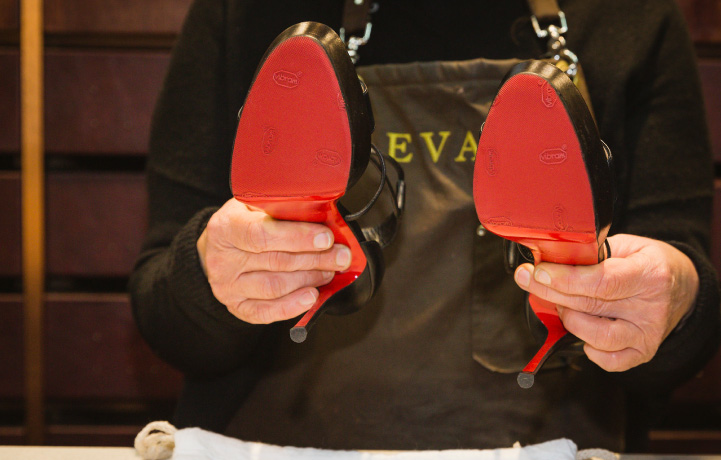Adding Rubber Soles to Your Shoes?
We’re often asked by our clients how do you protect leather soles and whether you should add TOPYs, Vibram or rubber sole protectors to the bottom of your shoes? This posts dispels some myths surrounding rubbers soles and weighs up the benefits of having this popular sole modification done to your leather shoes.

To Topy or not to Topy…
A common predicament faced by buyers after purchasing a new pair of expensive leather, luxury or designer shoes is whether to add rubber sole protection.
Many consider rubber as the best way of keeping leather soles watertight and protected from the elements. Others argue that the added rubber detracts from the shoes aesthetics, offsets balance and destroys them over time.
But who is right and what are actually the best methods of preserving the valuable bottoms of your shoes while keeping them looking the way you bought them and avoiding costly shoe repairs?

Authors Note
We’d just like to quickly mention that Topy has become a kind of proprietary eponymym. By this I mean “to Topy” (actually a French rubber company) has come to represent act of shoemakers or repairers applying rubber to leather soles. So for the purpose of clarity I’ll simply refer to the generic term of “protective soles” throughout this post.
At our shoe repair shop we actually work with Vibram rubber, which in our experience is of better quality, has greater style and colour variety than TOPY.
Sole Protection Myths
On the odd chance I get to speak with our customers I’ve noticed that there are few concerns about rubber soles. More often there is a sense of uncertainty about the process, particularly when it comes to a newly purchased pair of shoes. This is unsurprising given the lack of information available in regards to shoe maintenance.
Unfortunately with the loss of many quality shoe repairers or cobblers over the year most of what people hear is either anecdotal or from the retailer they purchase their shoes from. This has perpetuated a a number of myths about the process, most of which are simply untrue or based on little evidence.
The Added Rubber Offsets the Balance of Your Shoes
A concern is that the addition of rubber to your soles acts as a “top piece” that may offset the balance of your shoes. This is thought to cause your shoes to wear out quicker by exerting a greater force on the heels and insoles.
For this reason, we see of many luxury brands and shoe retailers actually warning their clients against adding protective soles to new shoes.
Of course, if the rubber is simply slapped on top of the soles this may lead to problems with balance. But as any shoe-maker worth his salt knows, leather soles always need to be sanded down a few millometres prior to the application of the rubber.
This serves two purposes. Firstly, to create a “bed” for the rubber to integrate seamlessly with rest of the shoes design. And secondly, to avoid the imbalance issues outlined above.
Even for designer heels with paper-thin leather soles, variations in the thickness of the rubber (down to 1mm) allows for seamless protection that doesn’t compromise the structure of the shoes.
Therefore if protective soles are applied to your soles in the right way with the correct materials, imbalance shouldn’t be an issue making such claims invalid.

The Added Rubber Ruins the Aesthetics of Leather Soles
There are some who just prefer the aesthetics of naked leather soles and will refuse to alter them in any way. But there are also those who are worried that protective soles will look tacky or detract from their shoes aesthetics.
Yes a shoddy job can make protective soles look terrible but again it really depends on the methods and materials being used by your shoe-maker.
If you risk your new shoes with someone whose careless or doesn’t appreciate their value, most likely you won’t be happy with the outcome. Like most things you get what you pay for and this is particularly true for the shoe repair industry.
Unfortunately we’ve seen a few disasters that make it understandable as to why people are put off applying protective soles to their new shoes.
Well, to those who’ve experienced sub-par work, we’re confident in saying that protective soles done properly look great.
While techniques may vary, the proper method essentially involves sanding back the leather, attaching the rubber with the proper adhesives and finishing the sole with a colour-matched edge dressing.
Variations in colour, thickness and styling also allow for a customised modification that suits the aesthetics of different shoes.
The aim of protective soles should always be for the rubber to complement the shoes design rather than become an unwanted modification
The Rubber Stops Your Leather Soles From Breathing
Some shoe traditionalists are firmly of the belief that leather soles should be allowed to breathe. The theory goes that placing rubber layers placed over the soles suffocates the leather fibres by depriving them of oxygen.
This point is really open to interpretation and depends on your beliefs and your overall shoe philosophy. There is no definitive answer or evidence to suggest that protective soles destroy your shoes by suffocating the leather underneath. In fact protective soles will only make your soles last longer.
In hotter climates perhaps you could possibly reconsider the need for protective soles due to the humidity and lack of moisture on ground. But this would be more of aesthetic preference rather than a practical response to increase sole breathability.
I’d just like to acknowledge that the above claims are not necessarily untrue and in an ideal world leather should always be exposed to air. However in the case of your leather soles, which undergo much duress, the long-term solution should always be to preserve and protect.
The Benefits of Rubber Sole Protectors
By now it should be clear that adding protective soles to your shoes is not a simple case of sticking a few pieces of rubber to the soles and trimming back the edges. Protective soles done right should be flush with the existing sole and complement the shoes original design.
Apart from looking great aesthetically, there are several important practical benefits to getting protective soles applied to your shoes.
Half Rubber Soles Preserve Your Leather Soles
The most obvious reason is due to the fact that your leather soles are going to take a battering. Exposure to the elements and natural salts, will contribute to the duress placed on your soles gradually eroding the leather.
Although leather is a durable material, it is not comparable to the properties of rubber in providing watertightness and protection. If you live in colder or wet climates protective soles are always a wise addition to your new shoes.

Rubber Soles Are Value For Money
In addition to extending the life of your shoes, protective soles save you money in the long run.
A full leather sole replacement (by either a shoe-maker or manafacturer) is up to 3x more expensive than getting protective soles done in the first place. For designer shoes recrafting new leather soles can be hundreds of dollars.
A relatively small investment gives significantly more life to your leather soles and allows you to avoid more expensive repairs down the track.
Applying protective rubber to your soles is clearly a far better value for money proposition if you want to get long-term wear out of your shoes.
Rubber Soles Are Anti-Slip
Leather soles may look great but the reality is that they do not offer the best traction for walking on smooth surfaces.
On a carpeted surface this is not really an issue but when walking on stone or timber floor you may begin to notice that leather soles become a hazard.
If balance is what you require, protective soles provide a practical solution.
Protective soles include a grip finish that is specifically designed to offer traction. A rubber overlay therefore offers a practical solution to the slippery surface of your leather soles that improves the stability of your shoes.
How Much Do TOPYs or Sole Protectors Cost?
A great benefit of rubber sole protectors are that compared to waiting to resole your shoes or purchasing a new pair they are a relatively inexpensive and long-lasting option.
If the shoes are brand new you would expect to pay between $45 – $90 at the higher end with the cost based on the reputation of the shoe repair shop and the materials on offer.
For example most shoe repairers will only stock a few colours of TOPY and a standard pattern others may also carry Vibram which offer different colours / styles suited to different types of shoes.
If your shoe soles have been worn they might require “building up” or leather toe pieces before the rubber sole protectors can be added. The cost of this additional repair process can vary from $25 – $75.
Its therefore a great idea to take your new shoes to a trusted Vibram or TOPY shoe repair service and have them TOPYed straight after purchase as it will save your additional shoe repair costs when the leather soles inevitably begin to wear.
Rubber Protectors vs. Naked Soles - The Verdict
So how do you best protect your leather soles, have rubber protectors applied or to leave them be?
Before I give a verdict, I’d just like to acknowledge that some traditionalists prefer to keep their soles looking exactly the way they were made. These people opt against sole protection based purely on aesthetic reasoning and this is entirely reasonable.
Looking at the more practical side of the argument, it appears that most opinions against sole protection stem from a misunderstanding of what the process actually involves. These myths seem to be perpetuated by retailers and luxury brands, who provide misleading information on what is a tried and tested method of preserving your leather soles.
Protective soles (when done the proper way) do not cause any long-term damage to your shoes. In fact rubber overlays significantly increase the lifespan of your soles and reduce the need for more expensive repairs at later stages.
Leather preservation, watertightness and slip resistance are all important reasons as to why many people opt for this modification to their shoes.
In addition protective soles done professionally with the right materials look fantastic and complement the shoes design.
If you are fond of your new shoes or can see yourself wearing the same pair on most days, getting protective soles done early is always the best option to maximise their longevity.
Ideally you should get protective soles applied straight after purchasing a new pair of shoes but theres also time to do it once you’ve worn the shoes in.
Just don’t wait too long as the longer you leave your soles exposed, the more expensive they are to rebuild or completely resole again.
